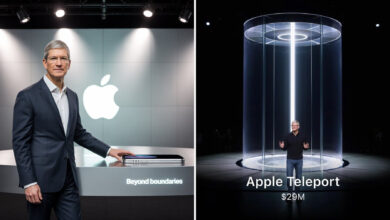Tech giants envision future beyond smartphones: 2025+ A New Era

Beyond Phones: The Ambient Tech Shift
The turning point why screens are Losing centre stage for more than a decade, smartphones have been the universal remote for modern life. They still matter, but the centre of gravity is moving. As multimodal AI, lightweight AR displays and ambient computing mature, computing stops living behind a rectangle and starts blending into everyday surroundings. It’s no mystery why Tech giants envision future beyond smartphones: the next wave promises calmer, safer, more contextual experiences that don’t demand your full attention every five minutes.
Crucially, Tech giants envision future beyond smartphones this shift isn’t about one device replacing another. It’s about a fabric of connected, context‑aware systems—glasses for glanceable visuals, agents for language and reasoning, wearables for sensing, and home/auto devices for orchestration. When each part does what it’s best at, the result feels less like a gadget and more like an assistant. You get what you need, when you need it, without spelunking through apps.
The $3 Trillion Post‑Smartphone Market. Technologies and Players
Analysts increasingly frame the post‑smartphone era as a multi‑trillion‑dollar opportunity this decade. Tech giants envision future beyond smartphones that figure captures hardware (AR glasses, wearables, sensors), software (agent platforms, spatial apps), and services (identity, security, orchestration). It’s an estimate, not a guarantee, but it signals where R&D and venture funding are flowing. The logic is simple: new platforms create new value chains—app stores, developer tools, accessories, analytics—and those stack up quickly when adoption turns the corner.

Who’s doing what? The playbooks rhyme but differ in emphasis:
- Meta is pushing consumer‑friendly glasses with contextual AI and social features, aiming for all‑day wear that looks like ordinary eyewear.
- Apple is cultivating spatial computing across hardware and software, betting on end‑to‑end polish and tight ecosystem hand‑offs.
- Google is building an open XR stack and ambient intelligence across devices, leaning on Android’s partner network.
- Microsoft remains enterprise‑first, pairing mixed reality with Azure AI for training, design and field service.
- OpenAI and others focus on AI agents that see, listen and act across tools, turning natural language into reliable outcomes.
- Neuralink and peers explore BCIs, with near‑term value in clinical contexts and longer‑term ideas for broader interaction—carefully, and with strong ethics.
Tech giants envision future beyond smartphones If this sounds crowded, it is. Yet competition is a feature, not a bug. It pressures everyone to improve comfort, battery life, privacy, and—most overlooked—developer ergonomics. The platform that makes building safe, delightful spatial and ambient experiences easiest will win hearts and roadmaps.
Core Technologies Powering the Breakout
Tech giants envision future beyond smartphones experience is built from several maturing layers. Each has moved from science project to practical engineering over the past five years, and together they finally click.
AR displays and optics
The hardest problems are still physics problems. Waveguides are getting brighter with wider field of view, while pancake lenses shrink bulk. Tech giants envision future beyond smartphones Foveated rendering cuts power by drawing in full detail only where your eye is looking. None of this is headline‑grabbing, but it’s what turns a two‑hour demo into an eight‑hour companion. The goal is all‑day comfort that looks like normal eyewear and plays nicely with prescriptions.
AI agents and multimodality
Agents are the universal adaptor for intent. They combine speech, vision, and context to understand what you want and execute across services. On‑device NPUs handle wake words, translation and object understanding locally; the cloud picks up heavy reasoning and long‑context tasks. The hand‑off must be seamless—if the network drops, the experience should degrade gracefully, not faceplant.
Ambient computing and edge
Ambient systems rely on local awareness: presence, light, sound, air quality, energy usage. Edge AI keeps sensitive data close to the source, reducing latency and risk. Meanwhile, a belt‑and‑braces approach—local first, cloud when helpful—protects privacy without sacrificing capability. Tech giants envision future beyond smartphones Think of it as calm technology: helpful when needed, invisible when not.
Tech giants envision future beyond smartphones Networking, chips and power
New radios (Wi‑Fi 7, early 6G research), better Bluetooth and ultra‑wideband support precise, low‑latency communication between devices. Specialised silicon—NPUs, DSPs, and efficient GPUs—delivers vision and speech at single‑digit watts. On the energy side, smarter power scheduling, low‑leakage components and modular batteries stretch runtimes. For low‑duty sensors, energy harvesting can even dodge the charger altogether.
What Is the Future of Smartphones?

They evolve into hubs rather than the star of the show. Tech giants envision future beyond smartphones will coordinate identity, security, and connectivity, and they’ll still shine for rich touch tasks—photo editing, long messages, full‑screen media. Yet a growing share of interactions will route through wearables, AI agents, and ambient interfaces that are faster and safer for quick, contextual jobs.
Think of daily life. Navigation becomes heads‑up and glanceable through AR; short replies are voice or gesture‑driven; home controls happen via presence and routines rather than a dozen apps. Tech giants envision future beyond smartphones Your phone is nearby, but it’s no longer the bottleneck for everything. In practical terms, consumers keep their handsets longer, while spending shifts toward glasses, earbuds, rings, and smart home gear that share the load.
What Will Be the Next Biggest Technology?
If you must pick one, bet on the duo of AI agents plus lightweight AR. The first understands intent; the second puts information where your eyes already are. Tech giants envision future beyond smartphones Together they reduce mental context‑switching—the silent tax of modern computing. An agent that can see what you see and hear what you ask can translate menus, summarise documents on your desk, or guide a repair without making you juggle screens.
That said, the story is broader than a single winner. Ambient computing will stitch in wearables, vehicles, and room‑scale devices; edge AI will make privacy‑preserving inference routine; and interoperability will decide whether your day feels smooth or stitched together with duct tape. The biggest technology, in that sense, is the system—devices, software and standards working in concert.
Strategies, Timelines and How Adoption Spreads
The next five years look less like a switch and more like a gradient. Early consumer AR glasses emphasise notifications, navigation and capture. Enterprise solutions lead in training, maintenance and logistics, where ROI is easiest to prove. Tech giants envision future beyond smartphones Meanwhile, AI agents step from chat windows into cars, kitchens and wrist devices, quietly becoming the glue between services.

By the late 2020s, expect a normalisation moment: colleagues wearing unobtrusive glasses in meetings; homes that mediate requests politely (‘lights down’, ‘start the extractor’) without exposing your life story to the cloud; vehicles that understand intent without a thicket of menus. Adoption spreads one solved pain point at a time. When something works reliably—say, live translation on a packed train—people use it again. Reliability, not razzle‑dazzle, is the growth engine.
Challenges and Consumer Realities (No Rose‑Tinted Specs)
Privacy and security
Continuous sensing can be magical—or creepy. Trust hinges on privacy by default: local processing where possible, clear indicators when recording, transparent data flows, and auditable logs. Users want off switches that really are off, and permissions that are short, specific and reversible. Passkeys over passwords, hardware roots of trust, and rapid patch pipelines are table stakes.
Comfort, etiquette and accessibility
If glasses feel like a gym workout for your face, they won’t go mainstream. Tech giants envision future beyond smartphones Designers must nail weight, heat, balance and prescription support. Social signals matter too: visible recording LEDs, tactile mute buttons, and modes respectful of classrooms, cinemas and meetings. Accessibility should lead, not lag—captions, high‑contrast modes, screen reader support in 3D spaces and configurable haptics help everyone.
Ecosystems and interoperability
Walled gardens can polish the experience, but they can also trap users and throttle innovation.Tech giants envision future beyond smartphones The sweet spot is open standards where they exist (graphics, identity, presence) and clear APIs where they don’t. People should be able to switch providers without rebuilding their lives from scratch. If ‘export’ isn’t first‑class, think twice.
Practical Steps: How to Prepare (Without the Hype)
For consumers
Start small. Choose products that respect privacy and work offline for core tasks. Prioritise comfort and battery life over party tricks. If a device can’t explain what data it collects and why, give it a polite pass. Your future self will thank you.
For organisations
Pilot with intent. Pick a process where spatial guidance or AI triage can move the needle—safety checks, onboarding, first‑line support—and define metrics before you begin. Use edge AI to keep sensitive data local. Document firmware, settings and network access so you can replicate success and troubleshoot fast. And yes, involve legal and security from the start; it’s cheaper than a retroactive scramble.
Bringing It Together: Where This All Lands
The post‑Tech giants envision future beyond smartphones era isn’t about novelty for novelty’s sake. It’s about calmer computing that reduces friction and returns attention to the world in front of you. Phones won’t vanish; they’ll share the workload with glasses, wearables and embedded systems that are faster for the job at hand. The platforms that thrive will earn trust through privacy, reliability and good manners, not just raw capability.
If you’re wondering why the industry is moving now, the answer is simple: the ingredients finally fit in the kitchen. Efficient chips, robust models, usable optics and better batteries make the recipes realistic. That’s why Tech giants envision future beyond smartphones—not because the phone failed, but because our lives are bigger than a sbu.



